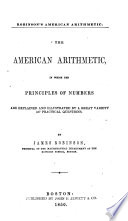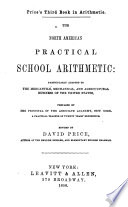 | James Robinson - Arithmetic - 1850 - 342 pages
...series of numbers in arithmetical progression, when we have the extremes and number of terms given. • RULE. Multiply the sum of the extremes by the number of terms, and divide the product by 2, the quotient will be the sum of all the terms. 1. The extremes of* an arithmetical... | |
 | Benjamin Greenleaf - 1851 - 332 pages
...multiplied by the number of terms, the product will be double the sum of either series. Hence, RDLE I. — Multiply the sum of the extremes by the number of terms, and half the product will be the sum of the series. Or, RULE II. — Multiply the sum of the extremes by half the number of terms, and... | |
 | Frederick Emerson - Arithmetic - 1851 - 342 pages
...two may be readily found. Theirs/ term. The last term. The number of terms. The common difference. The sum of all the terms. RULE. Multiply the sum of the extremes by the number of the terms, and half the product will be the sum of all the terms. See Theorem 4th. PROBLEM. I. The... | |
 | Charles Haynes Haswell - Engineering - 1851 - 346 pages
...what is the common difference 1 15— 3-H7— 1) = 2 Ans. When the Extremes and Number of Terms are given, to find the Sum of all the Terms. RULE. — Multiply the number of terms by half the sum of the extremes. EXAMPLE. — How many times does the hammer of a clock... | |
 | William Smyth - Algebra - 1851 - 272 pages
...To find, therefore, the sum of all the terms, when the extremes and the number of terms are given, Multiply the sum of the extremes by the number of terms, and take one-half of the product. Ex. 1. In a progression by difference, the first term is 5, the last... | |
 | Charles Haynes Haswell - Engineering - 1853 - 318 pages
...7; what is the common difference ? 15— 3-H(7~-l)=2 Ans. When the Extremes and Number of Terms are given, to find the Sum of all the Terms. RULE. — Multiply the number of terms by half the sum of the extremes. EXAMPLE. — How many times does the hammer of a clock... | |
 | Benjamin Greenleaf - 1854 - 342 pages
...multiplied by the number of terms, the product will be double the sum of either series. Hence, > RULE I. — Multiply the sum of the extremes by the number of terms, and half the product will be the sum of the series. Or, RULE II. — Multiply the sum of the extremes by half the number of terms, and... | |
 | Benjamin Greenleaf - Arithmetic - 1857 - 336 pages
...multiplied by the number of terms, the product will be double the sum of either series. Hence, RULE 1. — Multiply the sum of the extremes by the number of terms, and half the product will be the sum of the series. Or, RULE 2. — Multiply the sum of the extremes by half the number of terms, and... | |
 | Daniel Adams - 1858 - 354 pages
...extremes of the series ; hence, when the extremes and the number of terms are given to find the sum of tin terms, RULE. Multiply the sum of the extremes by the...number of terms, and half the product will be the sum of the terms. EXAMPLES FOR PRACTICE. 2. If the extremes be 5 and 605, and the number of terms 151,... | |
 | David Price - Arithmetic - 1858 - 264 pages
...third $10: what was the last payment? Ans. $37. II. The two extremes, and the number of terms being given, to find the sum of all the terms. RULE. — Multiply the sum of the extremes by half the number of terms. PROOF. — Divide the sum of all the terms by half the number of terms, for... | |
| |